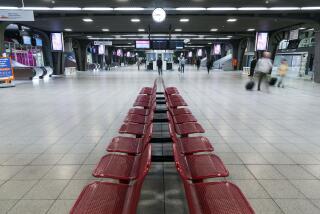Dutch Now Less Tolerant of Drug Scene
- Share via
AMSTERDAM — Erik Schoonderbeek emigrated from the Netherlands to California with his family at age 6, but returned when he was grown because the heroin here is cheap, plentiful and hassle-free.
The Netherlands still is an emporium of illicit drugs, but even the famous Dutch tolerance is waning.
In an attempt to reduce “drug tourism” before the European Community eliminates border controls next year, the government has announced it will prosecute drug abusers who create a public nuisance.
That reverses a policy of ignoring possession of drugs for personal use--up to half a gram of heroin or 30 grams of hashish or marijuana.
“The image Amsterdam had 10 years ago, that it’s a city where anything goes, is no longer true,” said Paul Vasseur, coordinator of drug policy for Amsterdam.
On the Zeedijk, a street running from the central railroad station through Chinatown, addicts lean into doorways out of the rain to freebase cocaine.
Hashish and marijuana, so-called “soft drugs,” are available at about 300 coffee shops in the capital. Many have marijuana leaves painted on their windows.
A menu at one popular tourist spot lists a dozen varieties of marijuana and hashish available in ready-to-smoke cigarettes or bags to go. “We get lots of Italians, French and Germans, especially around this time of year,” the manager said, on condition of anonymity.
Schoonderbeek, 32, became addicted to heroin in his teens. He returned to the Netherlands shortly after finishing high school, drawn by reports of the tolerance for addicts.
“I just wanted to be able to smoke a joint without being hassled,” was the way he explained it. Schoonderbeek said he uses heroin almost daily.
Amsterdam has been a drug Mecca since the late 1960s. Sales of hard drugs are concentrated around the prostitution district.
For the most part, the Dutch still regard drug use as the private affair of the user. Heroin addiction is considered an illness, not a crime; marijuana and hashish are viewed as recreational drugs unlikely to lead to addiction or criminal conduct.
Police have concentrated on stopping the traffic in heroin and cocaine, ignoring shipments of soft drugs destined for the coffee shops allowed to sell them.
Vasseur said prosecution does not cure hard-drug addiction and would put users of soft drugs in a criminal nether world where they would be likely to encounter heroin.
He described the Dutch approach to drug use as pragmatic rather than permissive, and cited figures showing a decline in Amsterdam’s estimated number of addicts in recent years from 7,000 to 6,000.
Addicts are less an outcast group here than in many other societies.
Because he is unemployed, Schoonderbeek gets a weekly welfare check equivalent to $150, but heroin costs $17.50 a fix. One recent day, he settled for a free dose of the synthetic narcotic methadone at a city-run clinic.
Holland’s addicts even have their own lobbying group. The Medico-Social Service for Heroin Users presses for more lenient drug laws and sends members to drug-abuse conferences abroad.
“Here they’re not treated like patients or criminals, just like people who take drugs,” said Julietta Tiemeyer, a social worker.
The Justice Department’s tougher enforcement policy responded to growing anger among residents of cities popular with drug tourists.
At Arnhem, on the German border, 150 residents vandalized soft-drug coffee shops two years ago. It plans to close half the 40 or so that still operate.
Venlo, another border town, has a similar problem with unruly drug tourists.
For most of the Dutch, however, drug use is a matter of live-and-let-live.
Andre, a 24-year-old window washer, bought a bag of hashish in a dingy cafe near the University of Amsterdam.
As he crushed the hashish, mixed it with tobacco and rolled a cigarette, Andre boasted: “I can smoke this anywhere I want--inside here, in the streets, in the park or even outside a police station.”
More to Read
Sign up for Essential California
The most important California stories and recommendations in your inbox every morning.
You may occasionally receive promotional content from the Los Angeles Times.










